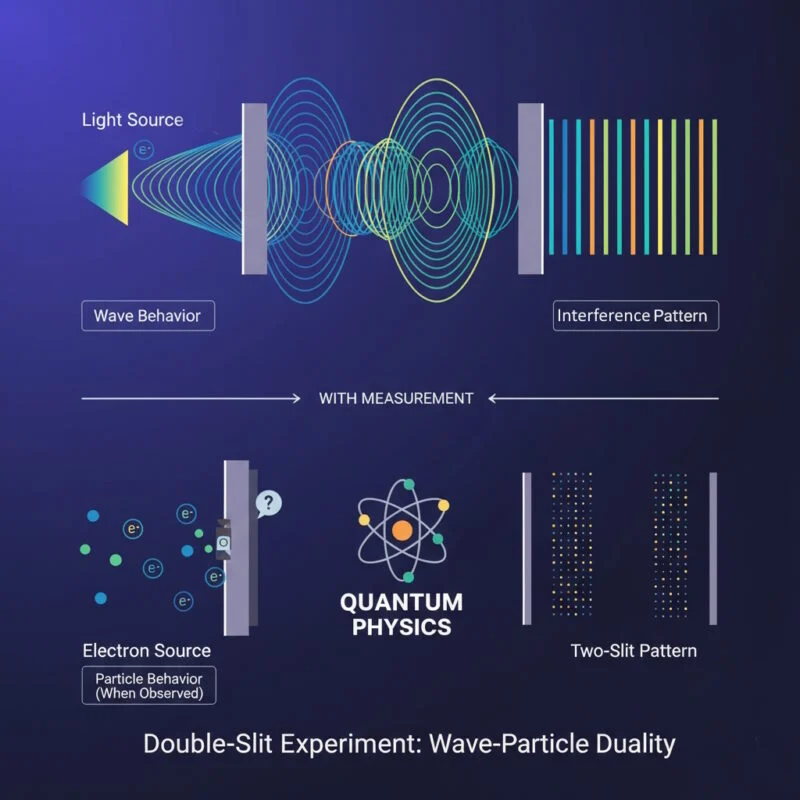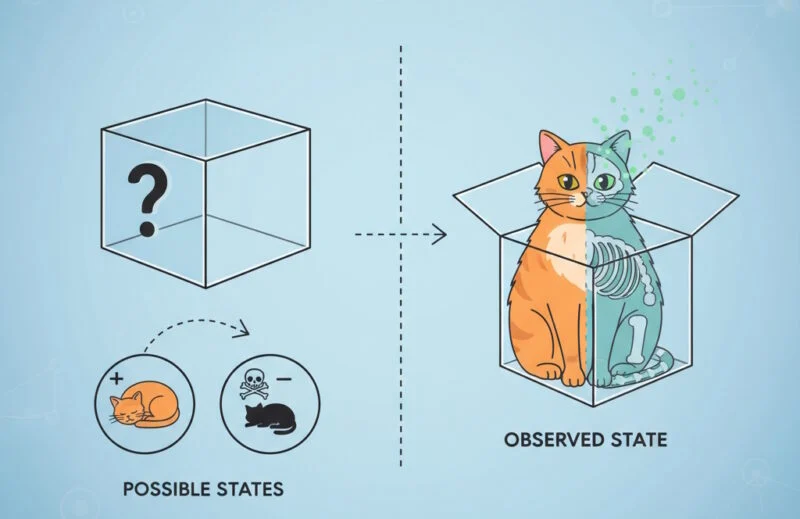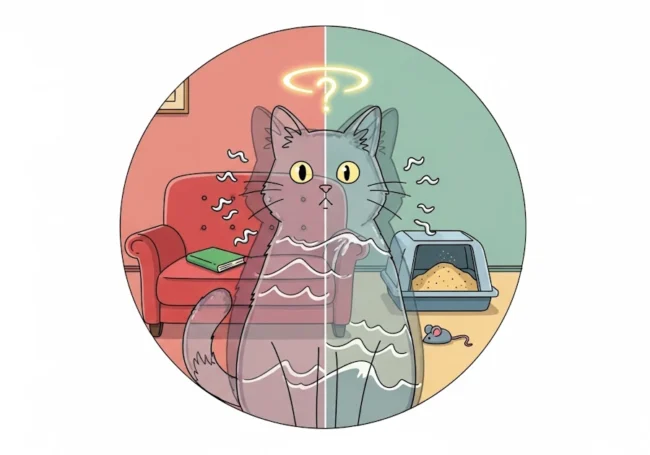Before we start discussing this concept, imagine flipping a coin. In mid-air, before it lands, is it heads or tails? Classical physics would say it’s definitely one or the other—we just don’t know which. But quantum mechanics tells a radically different story: at the quantum level, particles genuinely exist in multiple states simultaneously until the moment we observe them. This is quantum superposition, and it’s not just strange—it’s the foundation of reality itself.
- What is superposition?
- The double-slit experiment: seeing the impossible
- Schrödinger’s cat: a helpful illustration or a misleading metaphor?
- How large can superposition be?
- Quantum superposition in the real world: is it not just a theory?
- Is superposition mystical or just physics?
- Famous experiments that prove and probe superposition
- What does superposition tell about physical reality?
- What can we build using quantum superposition?
What is superposition?
Quantum superposition is the principle that a quantum system can exist in multiple states at once. Unlike our coin, which is always either heads or tails (we’re just uncertain which), a quantum particle in superposition is genuinely in all possible states simultaneously. It’s not that we don’t know which state it’s in—it literally hasn’t “decided” yet.
Think of it like this: a musical chord isn’t just one note—it’s multiple notes playing at the same time, creating something entirely new. Similarly, a particle in superposition isn’t merely in state A or state B; it’s in a combination of both states that has its own unique properties.
When we measure a quantum system, the superposition “collapses” into one definite state. Before measurement, the particle exists in a mathematical combination of possibilities. After measurement, we get a single, definite answer. This isn’t because our measurement revealed what was already there—the act of measurement fundamentally changes the system.
The double-slit experiment: seeing the impossible
The most famous demonstration of superposition is the double-slit experiment, which physicist Richard Feynman called “the only mystery” of quantum mechanics. The setup is deceptively simple: fire particles (electrons, photons, even atoms) one at a time at a barrier with two slits, and observe where they land on a screen behind it.
Here’s where it gets weird. Even when particles go through one at a time, they create an interference pattern—alternating bands of light and dark—on the screen. This is the signature of waves interfering with each other. But how can a single particle interfere with itself?

The answer: each particle passes through both slits simultaneously in a superposition of paths. It’s not that the particle goes through one slit or the other—it genuinely travels through both, and the two paths interfere with each other before the particle is detected on the screen.
The plot thickens: if you try to observe which slit the particle goes through, the interference pattern disappears entirely. The particle behaves like a classical object, going through one slit or the other, but never both. The superposition collapses the moment you measure it.
Recent experiments have even demonstrated this effect with molecules, pushing the boundaries of what we can put into superposition and bringing the quantum world closer to our everyday experience.
Schrödinger’s cat: a helpful illustration or a misleading metaphor?
In 1935, physicist Erwin Schrödinger proposed a thought experiment to highlight the absurdity of applying quantum superposition to everyday objects. Imagine a cat in a sealed box with a radioactive atom, a Geiger counter, and a vial of poison. If the atom decays (a quantum event), the poison is released and the cat dies. According to quantum mechanics, before we open the box, the atom exists in a superposition of decayed and not-decayed states. Therefore, the cat should be in a superposition of alive and dead states—simultaneously purring and not purring.

Is this a good example? Yes and no. It brilliantly captures the conceptual weirdness of superposition, but it’s deeply misleading in one crucial way: cats are not quantum objects.
The problem is decoherence. When quantum systems interact with their environment—and a cat is constantly interacting with trillions of air molecules, photons, and its own atoms—the delicate superposition state rapidly collapses. The larger and warmer the object, the faster this happens. For a cat, decoherence would occur so instantaneously that the superposition never meaningfully exists.
Schrödinger himself proposed the thought experiment not to explain quantum mechanics, but to show how bizarre it would be if quantum rules applied to large objects. The cat paradox isn’t a description of reality—it’s a challenge that led physicists to develop the concept of decoherence.
How large can superposition be?
For decades, quantum superposition seemed confined to atoms and subatomic particles. But modern experiments are pushing this boundary with stunning success.
- Molecules: Scientists have created superposition states with molecules containing over 2,000 atoms, demonstrating that quantum effects aren’t limited to the smallest scales.
- Photons and Interferometry: Light particles can be put into superposition states where they simultaneously take different paths spanning centimeters or even meters. These experiments show that superposition can extend across macroscopic distances.
- Superconducting Circuits: In quantum computing, superconducting qubits create superpositions of electrical currents flowing in opposite directions simultaneously. These circuits contain billions of electrons behaving collectively as a single quantum object.
In 2024, researchers achieved a record 1,400-second coherence time for a Schrödinger-cat state, meaning they kept a quantum superposition stable for over 23 minutes—an eternity in quantum terms.
- Mechanical Oscillators: Physicists have successfully put tiny mirrors and cantilevers into superposition states where they’re vibrating and not vibrating at the same time. While still microscopic, these are tangible objects you could theoretically see under a microscope.
The most important factor here isn’t just size—it’s isolation from the environment. The quantum-classical boundary isn’t a hard line at a certain number of atoms; it’s a gradual transition determined by how well you can isolate a system from decoherence.
Quantum superposition in the real world: is it not just a theory?
Quantum computing
Superposition is the backbone of quantum computing. While a classical bit is either 0 or 1, a quantum bit (qubit) can be in a superposition of both states simultaneously. This means a quantum computer with just 300 qubits could process more combinations than there are atoms in the observable universe—all at once.
When properly harnessed, this allows quantum computers to solve certain problems exponentially faster than classical computers, including drug discovery, cryptography, and optimization challenges.
Photosynthesis: nature’s quantum computer
Perhaps the most surprising place to find quantum superposition is in life itself. Research has shown evidence that photosynthesis exploits quantum coherence and superposition to achieve remarkably efficient light harvesting. This is already a quantum biology!
When a photon strikes a light-harvesting complex in a plant or bacterium, it excites an electron. This excitation energy needs to travel to a reaction center to be converted into chemical energy. Rather than taking a random path, the energy enters superposition states where it explores multiple pathways simultaneously, allowing it to “find” the most efficient route to the reaction center.
Think of it like someone simultaneously walking down every hallway in a building at once, then arriving at the destination via the fastest route. This quantum trick helps plants achieve nearly 100% efficiency in energy transfer—far better than anything we’ve engineered.
The debate continues about exactly how significant quantum effects are versus classical vibrations, but the evidence strongly suggests that evolution has discovered how to exploit quantum mechanics for biological advantage.
Some research suggests that migratory birds might use quantum superposition in their navigation systems. Certain proteins in birds’ eyes may exploit quantum entanglement and superposition to detect Earth’s magnetic field with extreme sensitivity. While still being actively researched, this would represent another example of biology harnessing quantum effects.
Is superposition mystical or just physics?
Here’s where we need to clear up a common misconception: quantum superposition is not mystical, spiritual, or evidence that consciousness creates reality. It’s a precise, mathematical description of how nature works at small scales.
What superposition is NOT:
- It’s not about the universe “splitting” into parallel realities (that’s one interpretation, but not the physics itself)
- It’s not proof that your thoughts can change reality
- It’s not evidence for telepathy, cosmic consciousness, or quantum healing
- It doesn’t mean “anything is possible” or that reality is an illusion
What superposition IS:
- A mathematically rigorous description of quantum states
- Experimentally verified countless times across multiple systems
- The foundation of technologies you use every day (lasers, transistors, MRI machines, GPS satellites all rely on quantum mechanics)
- Deeply counterintuitive to our evolved intuitions, but precisely predictable
Quantum physics it is something, that is hard to grasp, even for scientists, and the “weirdness” of quantum mechanics comes from trying to apply everyday intuitions to a domain where they simply don’t apply. An electron doesn’t need to “know” about superposition any more than water needs to “know” about wetness. It’s just how matter and energy behave at that scale.
The reason we don’t experience superposition in daily life isn’t because we’re “too big to be quantum”—we’re made of quantum particles, after all. It’s because decoherence happens so quickly that quantum effects average out into classical behavior before we can perceive them.
Famous experiments that prove and probe superposition
1. The Stern-Gerlach experiment (1922)
One of the first demonstrations that particles have intrinsic quantum properties. Silver atoms passing through a magnetic field split into discrete beams rather than a continuous distribution, showing that their magnetic spin exists in superposition until measured.
2. Quantum eraser experiments
These sophisticated variations of the double-slit experiment show that even after a particle has been detected, changing whether “which-path” information is available can retroactively determine whether interference (superposition) occurs. This isn’t time travel—it’s about what information is fundamentally available in the system.
3. Leggett-Garg inequality tests
These experiments test whether macroscopic objects obey quantum superposition or classical realism. Results consistently violate the classical predictions, confirming that even larger systems can exhibit quantum behavior when properly isolated.
4. Cavity quantum electrodynamics
Experiments that trap individual atoms or photons in highly reflective cavities allow physicists to create and manipulate superposition states with unprecedented control, keeping them coherent for longer periods than ever before.
5. Molecular interferometry
Recent experiments have demonstrated quantum interference with large organic molecules, showing superposition in systems approaching the complexity of biological molecules.
What does superposition tell about physical reality?
The implications of superposition challenge our most basic assumptions about the nature of reality:
- Reality isn’t definite until measured: Before observation, quantum systems don’t have definite properties—only probabilities for various outcomes. The universe at its most fundamental level is intrinsically probabilistic, not deterministic.
- The observer matters: This doesn’t mean consciousness is special, but rather that the physical act of measurement (an interaction between quantum and classical systems) fundamentally alters what’s being measured. There’s no such thing as a completely passive observation at the quantum level.
- Classical reality emerges from quantum fuzziness: The solid, definite world we experience isn’t fundamental—it’s an emergent property that arises when countless quantum superpositions decohere through environmental interaction.
- Information is physical: Quantum superposition reveals that information isn’t just an abstract concept—it’s a physical resource that can be manipulated, stored in quantum states, and fundamentally limits what we can know about reality.
What can we build using quantum superposition?
Understanding quantum concepts like superposition is one of the challenges of 2025 as quantum technologies drive exponential progress in computing, telecommunications, cybersecurity, and biomedicine.
Researchers are racing to:
- Create larger and longer-lasting superposition states to explore the quantum-classical boundary
- Build practical quantum computers that can maintain superposition in hundreds or thousands of qubits
- Discover other biological systems that exploit quantum effects
- Develop quantum sensors that use superposition for unprecedented precision
- Test whether gravity itself is quantum by creating superpositions of particles in different positions and observing gravitational effects
The boundary between quantum and classical isn’t just an academic curiosity—it’s the frontier where we’ll discover new physics and develop transformative technologies.

Leave a Reply